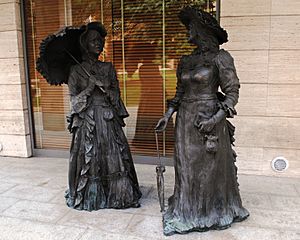Armando Palacio Valdés facts for kids
Quick facts for kids
Armando Palacio Valdés
|
|
|---|---|
![Photograph from Nuevo Mundo [es] by Manuel Compañy [es]](/images/thumb/5/55/Armando_Palacio_Vald%C3%A9s%2C_de_Compa%C3%B1y%2C_en_Nuevo_Mundo.jpg/225px-Armando_Palacio_Vald%C3%A9s%2C_de_Compa%C3%B1y%2C_en_Nuevo_Mundo.jpg)
Photograph from Nuevo Mundo
by Manuel Compañy |
|
| Born | Armando Francisco Bonifacio Palacio y Rodríguez-Valdés 4 October 1853 Entralgo, Spain |
| Died | 29 January 1938 (aged 84) Madrid, Spain |
| Language | Spanish |
| Nationality | Spanish |
| Genres | novels, short stories |
| Seat k of the Real Academia Española | |
| In office 12 December 1920 – 29 January 1938 |
|
| Preceded by | José María de Pereda |
| Succeeded by | Ángel González Palencia |
Armando Francisco Bonifacio Palacio y Rodríguez-Valdés (born October 4, 1853 – died January 29, 1938) was a famous Spanish writer. He wrote many novels and was also a literary critic.
Contents
About Armando Palacio Valdés
Armando Palacio Valdés was born in a place called Entralgo, in Asturias, Spain. This was on October 4, 1853. His father, Silverio Palacio y Cárcaba, was a lawyer. His mother, Eduarda Rodríguez-Valdés y Alas, came from a noble family. Armando was the oldest of their children. Interestingly, his brothers, Atanasio and Leopoldo, also became writers!
Early Career and Writings
Armando started his writing journey in a magazine called Revista Europea. He wrote smart and funny essays that people really liked. Because his writing was so popular, he soon became the editor of the Revista.
His best critical writings were put together in books like Los Oradores del Ateneo (1878) and Los Novelistas españoles (1878). He also wrote Nuevo viaje al Parnaso and La Literatura en 1881 (1882) with his brother, Leopoldo Alas.
Famous Novels
In 1881, Armando published his first novel, El señorito Octavio. This book showed how good he was at noticing details about people.
His novel Marta y María (1883) became very popular. It tells a story about someone trying to choose between a religious life and earthly desires.
More Popular Stories
- El Idilio de un enfermo (1884) was a very personal story, almost like a diary.
- José (1885) painted a realistic picture of people who work on the sea. It had strong characters named José and Leonarda.
- Riverita (1886) was a charming story. One of its characters became the main hero in Maximina (1887).
- From Maximina, a character then appeared in La Hermana San Sulpicio (1889). This book had romantic descriptions of Seville, a city in Spain.
- El Cuarto poder (1888) was about the world of journalism.
Later, Armando wrote Los Majos de Cádiz (1896) and La Alegría del Capitán Ribot (1899). In these books, and especially in Tristán, ó el pesimismo (1906), he showed his unique writing style. He became known as a writer who could deeply understand feelings and observe people with humor and kindness.
Royal Spanish Academy
Armando Palacio Valdés was chosen to be a member of the Real Academia Española (Royal Spanish Academy) on May 3, 1906. This is a very important group that looks after the Spanish language. He officially took his seat on December 12, 1920.
In 1935, some of his short stories were translated into English. Armando Palacio Valdés passed away on January 29, 1938.
Works
- Semblanzas literarias (1871)
- Los oradores del Ateneo (1878)
- El nuevo viaje al Parnaso (1879)
- La literatura en (1881), with Leopoldo Alas
- El señorito Octavio (1881)
- Marta y María (1883)
- Aguas fuertes (1884)
- El idilio de un enfermo (1884)
- José (1885)
- Riverita (1886)
- Maximina (1887)
- El cuarto poder (1888)
- La hermana San Sulpicio (1889)
- La espuma (1890)
- La espuma (1891)
- La fe (1892)
- El maestrante (1893)
- El Orígen del Pensamiento(1893)
- Los majos de Cádiz (1896)
- La alegría del capitán Ribot (1899) ("The Joy of Captain Ribot", 1900)
- Tristán o el pesimismo (1906)
- La aldea perdida (1911)
- Los papeles del doctor Angélico (1911)
- Años de juventud del doctor Angélico (1918)
- La novela de un novelista (1921)
- Cuentos escogidos (1923)
- La hija de Natalia (1924)
- El pájaro en la nieve y otros cuentos (1925)
- Santa Rogelia (1926)
- Los cármenes de Granada (1927)
- Testamento literario (1929)
- Sinfonía pastoral (1930)
- El gobierno de las mujeres (1931)
- Obras completas (1935)
- Álbum de un viejo (1940)
- El Crimen en Calle de la Perseguida (Unknown)
See Also
 In Spanish: Armando Palacio Valdés para niños
In Spanish: Armando Palacio Valdés para niños
In English
- Literary realism: General vision of the movement
- Spanish literature: Evolution of Spanish literature
In Spanish
- wikisource:es:Armando Palacio Valdés
- Literatura española del Realismo


